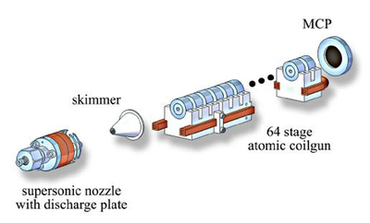March 17, 2008 feature
Atomic Coilgun Halts Supersonic Beams

By magnetically pulsing a sequence of 64 copper coils in an “atomic coilgun,” scientists have succeeded in stopping a supersonic neon beam in its tracks in just microseconds.
The researchers, from the University of Texas at Austin and Tel-Aviv University, have published the results of their experiment in a recent issue of Physical Review Letters.
In their study, the scientists show how switching high magnetic fields on and off as an atomic beam passes through the coils can remove more than 98% of the beam’s kinetic energy. With their method, they decrease the velocity of an atomic neon beam from 447 m/s to 56 m/s.
“We have stopped the beam completely, but in order to extract the atoms to the detector we leave a small residual velocity of 56 m/s,” Mark Raizen, physics professor at the University of Texas at Austin, told PhysOrg.com. “In the future, we do intend to stop and trap the atoms. We will be able to hold them in a stationary trap and then, to detect them, we will have to re-launch them with several additional stages of the coilgun.”
The atomic coilgun – with its electromagnetic copper coils – acts upon the magnetic moments of the neon atoms in the beam. (Basically, a magnetic moment is the atom’s internal magnetism, which is caused by the movements of its electrons.) Any atom or molecule that has an unpaired electron can be slowed by the atomic coilgun.
“The atomic coilgun is very appealing because of its universal nature, working on about 90% of the periodic table and some molecules – radicals and oxygen,” Raizen said. “There really are no other good methods for slowing beams of atoms, aside from laser cooling, which only works for about 10% of the periodic table.”
In their set-up, the scientists generated a cold, fast neon beam, which travels through a funnel-shaped “skimmer.” The skimmer directs the atomic beam into the coilgun, which consists of 64 copper coil solenoids spaced 14 mm apart. After traveling through the magnetically pulsed coils, the beam propagates to a microchannel plate, where the scientists can measure the speed of the atoms in the beam.
The key to the coilgun is the ability to control the electromagnetism of each of the copper coils individually. Using data from simulations, the researchers created a timing sequence for turning each coil’s electromagnetic field on and off.
“An important feature [of the atomic coilgun] is its simplicity, with copper wire coils driven by discharging capacitors,” Raizen said.
As an atom moves into the center of a coil rather than in between coils, it experiences a stronger magnetic field and gains potential energy. But when the coil’s field is turned off with the atom in the center, the atom loses much of its kinetic energy. The loss happens quickly: when the current is switched off, a coil’s 5-tesla magnetic field decreases by about 80% in 6 microseconds.
“The amount of energy that is removed per stage is equal to the height of the magnetic hill,” Raizen said, explaining that the exact amount of energy depends on the type of atom. “We remove 1/64 of the atom's kinetic energy per stage.”
As the researchers explain, the timing sequence of the coils is important. If a coil’s field is switched off when an atom is positioned in the center of the coil rather than in between coils, the atom experiences a stronger magnetic field and is slowed more. However, switching the magnetism off when atoms are in between coils allows more atoms to be slowed.
The ability to dramatically slow and stop a supersonic atomic beam could enable researchers to study atomic and molecular properties in great detail. The group is currently working on trapping and cooling atomic hydrogen isotopes, such as tritium. Analyzing tritium could enable researchers to make precise measurements of beta decay, which in turn could provide a way to determine neutrino rest mass – one of the greatest unanswered questions in physics.
Other possible applications include using the atomic coilgun to trap several types of cold atoms, opening up new directions in cold chemistry. Stopping atoms such as iron and nickel could enable controlled deposition of magnetic quantum dots, and might also serve as a method for magnetic storage.
More information: Narevicius, Edvardas; Libson, Adam; Parthey, Christian G.; Chavez, Isaac; Narevicius, Julia; Even, Uzi; and Raizen, Mark G. “Stopping Supersonic Beams with a Series of Pulsed Electromagnetic Coils: An Atomic Coilgun.” Physical Review Letters 100, 093003 (2008).
Copyright 2008 PhysOrg.com.
All rights reserved. This material may not be published, broadcast, rewritten or redistributed in whole or part without the express written permission of PhysOrg.com.





















